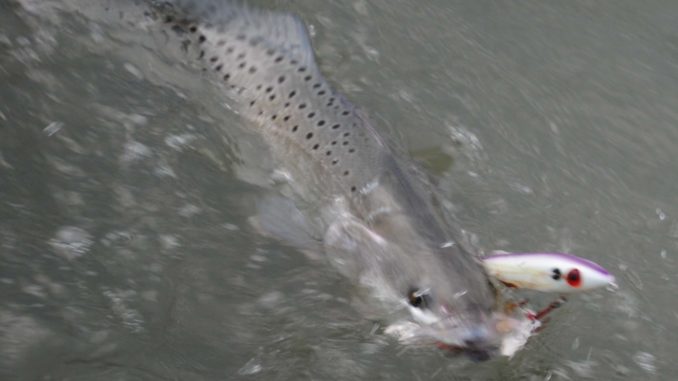
November is prime time for anglers to experience the thrill of a big speck blasting a topwater plug.
Catching a big speckled trout on a topwater bait is something of a religious experience to some fishermen. Count guides Danny Rourk and Jeff Yates among them.
It’s about the bite and the fight.
“When a trout hits a topwater bait, I get the same feeling I do when I see a big cobia turn and come at something you’ve thrown at him,” Rourk said. “Your whole body reacts. It’s almost like jumping a tarpon.”
“A big trout, four or five or six pounds — that’s a different animal,” Yates said. “They fight with so much ferocity, the head shaking is so violent. It makes my blood boil when I miss one of those.”
That’s what makes the fall one of their favorite times to fish. The cooling waters along South Carolina’s coastline indicate to trout and every other fish species that winter is coming, that it’s time to put on the feed bag. And the change in trout behavior is perhaps more abrupt than other fish that patrol the saltmarshes and tidal creeks.
And even though the cold-water kills the past two winters put a huge dent in the trout population, the next five or six weeks, Rourk and Yates agree, is prime time to get a big speck to take a swipe at a topwater bait.
“It will get a little better the cooler it gets, right up to when the shrimp and mullet leave,” said Rourk (843-263-3863), who operates Tailwind Charters in his hometown of Beaufort. “The fall is when topwater fishing is the best, because the mullet are in, and everything is trying to fatten up for the winter.”
Yates (843-270-8956), who runs Ty-Jo Knot Charters out of Mount Pleasant, is recognized as one of the best trout fishermen in the Charleston area. He is part of a fishing family; his father, David L. Yates, is a licensed captain and guide, as is his brother, David. Jeff Yates readily admits that he’s a trout fanatic and a topwater fanatic because of his father’s influence.
“My dad is the master,” he said. “He was throwing topwaters for trout back in the 80s, before people around here even knew what a topwater was. He’d buy Florida Sportsman magazine and read articles about things they were doing in Florida that nobody was doing up here. Then, he’d be up at the crack of dawn, catching trout on a Zara Spook or Tiny Torpedo.
“I learned all of my techniques for catching trout from what my father taught me, and what he taught me helped me go out and find all the spots I fish.”
The topwater bite for speckled trout is generally an early morning, late afternoon bite, except on days when cloud cover dominates. There aren’t any “special” places where trout are more likely to hit a topwater plug than, say, a live or artificial shrimp suspended under a cork; Yates said: “If it’s a good trout spot, they’ll hit a topwater bait sooner or later.”
Rourk knows the kind of spot where he’s caught trout on topwater, and he’s constantly on the lookout for them.
“I like to fish a topwater bait on a bigger tide — incoming or outgoing — and I like to fish a topwater bait on a long oyster point, one that sticks way out (in a river or creek) and still has a couple of feet of water on it,” he said. “The trout can come out of the deeper water and feed, and you know all the baitfish are going to come over the top of the point. If I was in pursuit of the biggest trout on topwater, that’s where I’d look.
“Another thing is, I like to stay off a place like that. A mistake a lot of people make is not knowing where it is and motoring right up on top of it. That will spook ’em off it.
“I like to set up a long cast away and work the bait over it. And that’s the beauty of a big topwater bait. You can sling them a long way and cover a lot of ground with them. If I’ve got a trip with two guys who can really cast, I can get on the poling platform in the back and we can really cover a lot of water.”
Yates said the magic depth for him has been four feet, no matter what kind of place it is — as long as it’s a spot where he catches trout: a deep marsh bank, a long point or sandbar that’s a current break, whatever.
“In clear water, I’ve seen ’em come up and hit a topwater bait from five feet deep,” he said. “The water temperature needs to be above 60 degrees, and the closer to 70, the better. November is a great time to catch trout on topwater as long as the water temperature is 60 degrees or above.”
Besides the adrenalin rush from an explosive, splashy topwater strike from a trout, Rourk and Yates agree that one of the big advantages of catching a trout or two every morning on a topwater bait is that they’re going to almost always be bigger trout.
“You don’t get too many 12- and 13-inch trout on a topwater bait,” Yates said. “Most of your bigger trout are eating small fish. When they get bigger, their diet changes off of shrimp and crustaceans to fish. If I’m tournament fishing, I’ll fish a topwater bait the first couple of hours for that big fish. I know I’ve seen a lot of guys out still catching bait, and I’m already running back to the (scales) with a 5-pounder in the boat.”
Rourk feels like a lot of fishermen underestimate how big a bait a speckled trout can eat; even a 2- or 3-pound trout can make quick work of a big baitfish.
“A 5-inch pinfish, that’s a big bait, but a big trout will bust one of those in a minute,” he said. “A small trout can’t handle a big bait, but when you think of a big trout, 22 to 24 inches, he can eat a pretty substantial mullet. He can eat a bigger mullet than you think he can, and he doesn’t mind chasing a little, because he knows he’ll get a big meal.”
If Yates emphasizes anything when talking about catching trout on topwater, it’s to be out there early, that trout are more likely to bust a big surface plug under low-light conditions.
“If it’s rainy or cloudy, you can catch trout all day on a topwater bait, but most of your trout are going to hit topwaters right about dawn,” he said. “You need to be there, waiting, at the crack of dawn.
“It was hard for me when I was in my 20s to be up at 4:30 to go fishing on the weekend when I was getting up at 6 during the week to work construction,” he said. “But you know if you’re there, you’re going to get one or two strikes in the morning that could be the one.
“I love getting to my first spot in the dark. You can’t see ’em, but if you’re sitting there, just waiting for it to get light, and it’s dead quiet, you can hear ’em slurping down baits. I get ready the night before. I have everything tied on, ready to go, so I’m not trying to tie stuff on the next morning. I want everything in the boat so all I have to do is reach for it.”
Topwater baits come in a number of shapes and sizes. Rourk has three that he has tremendous confidence in: a chartreuse Skitterwalk, a chrome Super Spook and a red/white Top Dog.
“I need to experiment, but those are the three I pick up,” he said. “The other day, I happened to have a red/white Top Dog tied on, and there were a lot of mullet out there, and I handed (a fisherman) that rod, and he caught a couple on it.
“But if you talked to 10 guys, they would all like something different; they’d all have their favorites.”
Yates’ favorites are a Spook and a Tiny Topedo, the latter a smaller, cigar-shaped prop bait, and he’ll occasionally throw a Chug Bug, a bigger, chugging-type lure.
“A Zara Spook is probably my No. 1 topwater bait,” he said. “It was a big freshwater bait forever, and they finally converted it to saltwater by putting galvanized hooks on them. You can catch them on it in smooth water, choppy water and real choppy water. I keep it constantly moving; I think you often get kind of a reaction bite.”
Rourk and Yates agree that fishing a Spook with a consistent walk-the-dog retrieve is usually the best technique. Fished with a snap of the wrist, the bait will dart from side to side, recovering in the millisecond when there’s slack line.
“I just like to walk a Spook with a consistent retrieve,” Rourk said. “My first cast to a spot, I’ll always retrieve with a consistent ‘pop-pop-pop-pop’ cadence. After that, I may vary it a little. I may retrieve it ‘pop-pop-sit-pop-pop-sit.’”
Rourk fishes a topwater bait on medium-light to medium action spinning tackle, the reel spooled with 10-pound braided line tied to a 3-foot section of 20-pound fluorocarbon leader.
“I’ll throw the chartreuse Skitterwalk to start with, and if I get into a bite, I’ll have somebody else on the boat throw a Spook to see if they want it more,” he said. “I love to fish it early in the morning in really flat water. You can hear everything that’s going on. There’s something about throwing it around 8 a.m., in flat water on a high tide.”
Rourk cautions fishermen that topwaters are not for everybody. You have to be totally committed to catching fish on one to be successful. You may fish a topwater an hour for two strikes.
“You have to persevere to fish a topwater,” he said. “You can’t throw it one or two times and expect it to work. You’ve got to want to throw it to catch fish on it.”
If they miss it…
A topwater bait isn’t the easiest thing for a trout to hit, so it’s not unusual to have a speck hit a big topwater plug and knock it completely up in the air — but not get hooked.
A “swing and a miss” presents fishermen with an unusual opportunity that Jeff Yates and Danny Rourk recognize.
“You get a lot of ‘short strikes,’” Yates said. “When they miss a Zara Spook, a lot of people will just let it sit, and that’s the biggest mistake you can make.
“You need to keep it moving. The trout has missed the bait, and you’ve got to make it look like it’s escaping, like it’s panicking. When he misses it, you’ve got to keep it moving for at least two or three feet. That will work really well.”
Rourk likes to get his bait back to the boat and make another cast as quickly as possible when he gets a short strike on a topwater bait.
“If a fish blows up on your topwater bait and misses it, nine times out of 10, if you can throw it right back in the same spot and retrieve it the same way, that same fish will hit it again.”
Trout are particularly apt to come back at a bait a second time, Yates said, because they usually strike from below and to the side of a bait. Unlike more mobile fish, when a trout strikes at a bait and misses on the rise, it usually noses over and heads back toward the bottom. When the fish gets turned around, it’s looking up at the surface, hoping to see a wounded baitfish sinking or struggling at the surface.
It’s a common practice among freshwater fishermen to have a “follow-up” bait tied on a second rod that’s within easy reach. That way, the angler can grab the second rod and cast directly to the spot where the strike was missed. The key is, a bait that will sink slowly, down into the trout’s field of vision, is required. Heavier soft-plastics such as Senkos are perfect because they can be cast long distances, and they’ll sink when they hit the water.
The trout progression…
Jeff Yates credits his father with developing a progression of baits for speckled trout that allows fishermen to target them at basically any depth.
“My dad would start with a Zara Spook, and if they wouldn’t hit it, he’d go with something slower, like a Tiny Torpedo, that he could just wiggle a little, then pop it across the top,” he said. “If they weren’t interested in that, he would go to a shallow-running crankbait like a Catch 2000 that wouldn’t run more than a foot deep.
“After that, he’d fish a MirrOLure that he could fish in the middle of the water column, and if that didn’t work, he could drag the bottom with a grub on a jighead.”
Yates said his father discovered that a Tiny Torpedo was a killer trout lure while looking for something to substitute for a Spook when trout weren’t interested in the bigger bait.
“It was a smaller bait, and you could retrieve it with a steady retrieve. You can cast a Torpedo and let it sit, and you can move it just enough to make rings, then count to 10, then kind of snatch it. That sounds just like a menhaden.”

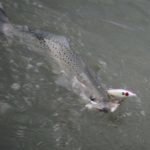
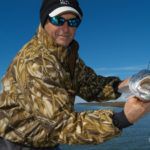
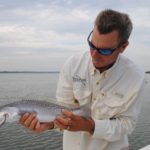
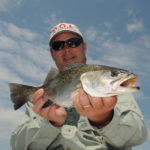
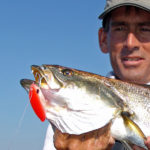
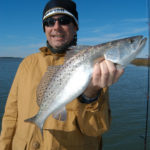




Be the first to comment